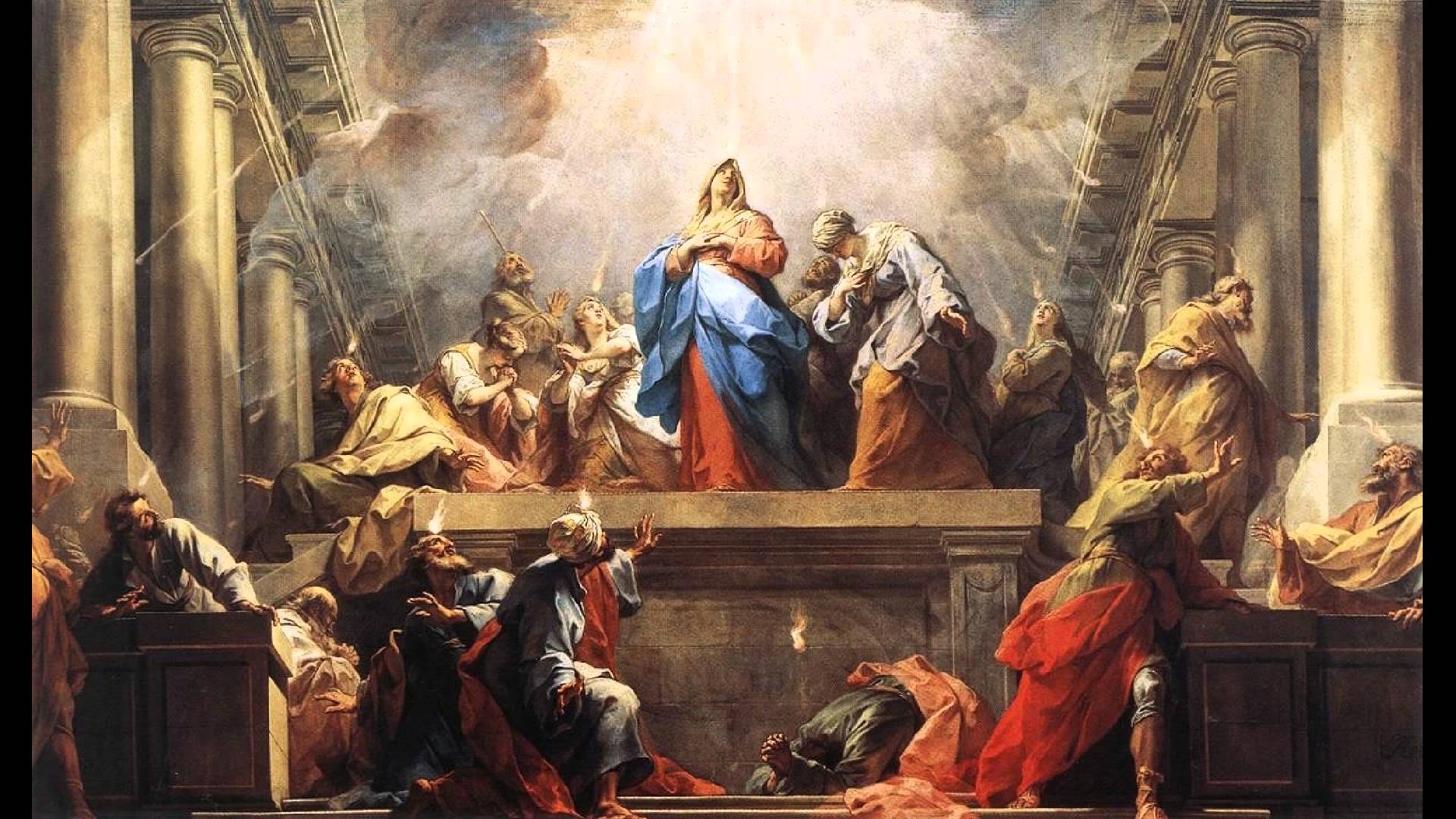
04 Jan Reflections on the Glorious Mysteries
The Resurrection
St John invites us to see what love the Father has given us, that we should be called children of God. The love given us by the Father is the Son, and it is in our conformity to the Son that we are made children of the Father. But our conformity to the Son is not yet complete and we cannot yet see Him as He is, Risen in His flesh. And so St John says that although we are God’s children now, it does not yet appear what we shall be, but we know that when He appears we shall be like Him, for we shall see Him as He is.
While we are still un-like Him, while we remain as yet un-risen, we cannot see Him, cannot apprehend the Risen One as He truly is. This is what the disciples discover in the Forty Days in which the Risen Christ discloses Himself to them – and therefore also to us – so enigmatically. The enigma, however, isn’t in Him, it’s in the disciples, and in ourselves. It is they, it is we, who are caught, suspended, between the mortality which belongs to the present order of things and the immortality which is the future in Christ. The Risen Christ already fully and sovereignly inhabits the space in which all things are renewed: as the Catechism teaches, from the moment of the Resurrection Christ’s humanity belongs only to the Father’s divine realm. Indeed in His own Person He is the space of universal renewal, for everything is in Him, and He is Himself, as He tells us, the Resurrection and the Life. It is we, the as-yet-unrisen, who are in transition, poised between present and future, incapable of truly apprehending the Resurrection because we cannot, yet, apprehend what is ultimately real.
And yet, like the disciples in the Gospels, neither do we fail altogether to apprehend it. For the ultimate reality, the Resurrection, which presently lies beyond our grasp, is nonetheless not another reality, separate and different from the world that we already know; it is a transformation of the world we know – of this very world, just as it will be our very bodies, our bodies here and now, that one day rise again. So there is continuity, and there is transformation. Like the Risen Christ, the future – which is His – is both present and hidden, given and still awaited, it is both now and is also not-yet. This is the condition precisely of Faith and of Hope, in which we await from God the gift of fully receiving what He has already given us. We await the gift of finding ourselves and our world handed to us by the Risen Christ, to Whom everything has already been handed over by the One He calls my Father and yours. And in this, beyond even Faith and Hope, we behold the seal of Love, the Love of the Father by which the Son was raised from the dead, the Love which, in the Risen Son, pledges to raise us too.
The Ascension
Our hope is for heaven, and therefore to see God. But what does seeing God mean? We shouldn’t too readily think this is just a metaphor for something intellectual or spiritual. And the Ascension shows us why. To see God is, for us, to see the Risen and Ascended flesh of the Incarnate Word, which He has taken into the very heart of the Divine, to the bosom of the Father. This cannot be a purely intellectual or spiritual vision; we see God in seeing the body that He has taken to Himself.
For the flesh assumed by the Word, and taken up by Him to the right hand of the Father, doesn’t simply fall away as somehow unimportant to heavenly vision. The Word made flesh does not cease, in heaven, being our mediator. His Crucified and Risen Flesh mediates always, not only as our Redeemer, while we are still on earth, but also in eternity, as the ground and context of our vision of the Trinity. That is why our Resurrection is essential to our enjoyment of the fullness of Heavenly life; in order to see the Risen and Ascended humanity of Christ, in seeing which we see the Divine Persons themselves, our bodily power of sight must be restored, and indeed all our bodily powers of apprehension. The Ascension, then, is our pledge that it is the life of man, not of his soul alone but of man himself, that is intimately fulfilled in the vision of God.
The Descent of the Holy Spirit
From Christ we hear of the Counsellor, whom I will send to you from the Father, even the Spirit of Truth, who proceeds from the Father, [and who] will bear witness to me.
Now what witness to Christ does the Spirit bear? He bears forms of witness which make possible Christian life as such. And to speak of Christian life as such is to speak, not first and foremost of our adhesion to the letter of the Gospels, the Creeds or the teachings of the Church – indispensable though all this be. It is rather, first and foremost, to speak of an interior gift, a gift from the heart and to the heart.
It is by the Spirit that we can have Faith at all, by Him that we can pray, by Him that Christ is made present in the Eucharist so as to feed us, and it is by the Spirit that whatever Christians do and whatever they suffer attain their Christ-like spontaneity and fertility. The Spirit witnesses to Christ, not by witnessing to someone external to us or beyond us, to someone we can point to as here or there, like an object. The Spirit witnesses to Christ by conveying Christ to us interiorly, by expounding Him to us and in us as life, so that our very lives are increasingly conformed to His. This conformity, even now the seed of eternity in us, can take place only in the shadow, sometimes experienced as darkness, left by His worldly absence. This is what connects the Ascension to the giving of the Spirit. In the Ascension, Christ withdraws, evades our grasp. And in that absence, He gives Himself in a new and transforming way, not to be held onto, but to be received and lived in the Spirit, now and forever.
The Assumption
Our Lady’s Assumption, like the Resurrection of Christ from which it flows, is the profoundest possible contradiction of the idea that our Faith requires us to think of human life as an essentially spiritual, disembodied existence. Human life isn’t a theatre of war waged against the body for the sake of attaining an angelic freedom from the flesh.
Our bodily lives can all too easily take on one or another form of ultimately sub-human exhilaration. There can all too easily be excesses either of austerity and fastidiousness, or of sensual curiosity and adventure.
Such excesses deny the humanity to which the Assumption witnesses. The radical extremes, whether of contempt or of indulgence, are untruthful, even if they can appear easier than the truth to embrace, and in some ways, and to different kinds of people, also more appealing than the truth. But the truth is that Christianity is the religion of the Incarnation. We believe that out of love for what He has made, God the Son not only took flesh to Himself for a time, but also rose in the flesh and in the flesh ascended into eternity. He lives an embodied life not only in time but also in eternity, a life forever expressed in human flesh.
We cannot think of our Lady’s Assumption adequately unless we think it in these terms. The Assumption means that in Mary God chose to manifest, for the first time in a human person, the Incarnational fulness of His redemptive love for us. Despite what we often say, God does not want souls. He wants human beings, that is to say, He wants living human bodies, united to Himself in love. This is what the Assumptions tells us.
The Coronation
In the writings of St Thérèse of Lisieux, there is a passage in which she responds to something she has heard or read about our Lady’s coronation as Queen of heaven. The claim that St Thérèse responds to is that in her coronation Mary’s singular glory outshines that of all the other saints combined. And Thérèse rejects this thought, pointing out that there is something rather grotesque in the idea of a mother outshining her children.
There is something profoundly right about what St Thérèse says here. Our Lady’s coronation is the consummation of her fulness of grace, and the grace which achieves a fulness in her is the grace of Christ, which is not about outshining anyone. On the contrary, the Incarnate Son chooses not to shine, but rather to empty Himself, taking on the condition of a man, of a slave, and finally the helplessness of death itself. In this self-emptying, to which the Father responds by raising Him from the dead, lies the whole meaning of the grace of Christ – the grace that is simultaneously His and which He communicates to us, and among us preeminently to His mother. If there is something which shines here, it is not well captured in images of worldly exaltation. That by which Mary is crowned is her intimate likeness to her crucified and risen Son, Who in both crucifixion and resurrection pours Himself out for the salvation and transformation of the world. What shines in Mary, what crowns her, is her unique participation in Trinitarian Love, receiving it in herself and mediating it to us. As St Thérèse understood precisely, this is a grace not of outshining but of unobtrusiveness, of selflessness, one might almost say invisibility, as the Gospels confirm. Christian discipleship knows no other coronation than this.
By Fr Philip Cleevely, Cong. Orat.

